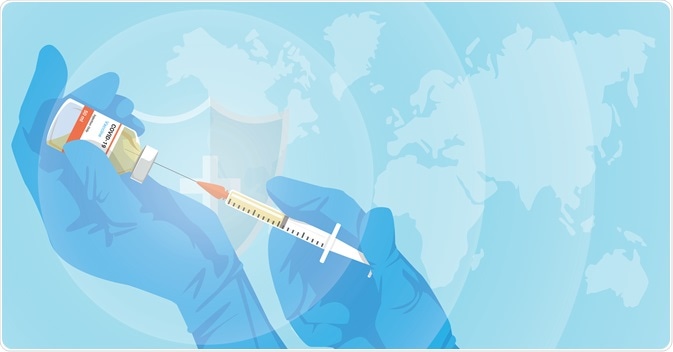The Future of Vaccines

World Immunization Week offers the scientific community a platform to showcase the most forward-thinking vaccination developments. This sharing of information allows scientists to educate themselves on the directions that vaccinations are taking and how they will improve the health of people across the globe, which is particularly relevant to preventing new diseases such as COVID-19 and ensuring old ones don’t reemerge.
World Immunization Week gives key insights into the key advancements in the field; here, we discuss the current innovations in vaccine technology that are driving the future of healthcare.
 Image Credit: Foxeel/Shutterstock.com
Image Credit: Foxeel/Shutterstock.com
The rapid development of new vaccinations
Traditionally, vaccines take over a decade to research, develop, and be confirmed as safe for use in humans. For many years, scientists have recognized that this process is not fast enough to respond to novel infectious diseases.
Before COVID-19 emerged, scientists had been working on cutting-edge platform technologies to change the vaccine development landscape. In particular, a team at Imperial College London had been working on a groundbreaking new platform known as Rapidvac that aimed to develop new vaccines in months instead of years.
When COVID-19 became a global pandemic, scientists were under immense pressure to develop a new vaccine in a short timeframe. Thanks to developments like Rapidvac, scientists were equipped with the tools to create new vaccinations in record-breaking times. Before 2020, the fastest development of a vaccine had been the four years it had taken to get the mumps vaccine approved back in the 1960s.
What was achieved with the COVID-19 vaccines demonstrates a possible paradigm shift in vaccine development and deployment. It shows how vaccines can rapidly and effectively developed in short time frames to respond to novel diseases.
Syringe-less vaccines
Historically, syringes have been vital for administering vaccinations. Rates of trypophobia, the fear of needles, are fairly prevalent in the population, with recent studies estimating that around 20-50% of adolescents and 20-30% of young adults exhibit fear of needles. Therefore, the efficacy of controlling diseases via syringe-delivered vaccines is limited as there will always be a percentage of the population who will avoid taking the vaccine due to a phobia.
To overcome this issue, scientists are developing a method of delivering vaccinations via micro-patches. A team at the Hilleman Labs in India has recently developed such patches that could be used to vaccinate against Hepatitis B.
The method of patch-delivery also has further advantages, such as that they are cheap to make and easy to store, whereas many syringe-delivered vaccines are required to be kept at cold temperatures so that they remain viable. Therefore, patch-delivered vaccines offer rural and poor communities access to vaccinations that previously may have been out of their reach.
Iris scanning helps to establish digital vaccine records in developing countries
The 2014-2016 Ebola outbreak that hit West Africa was the largest and most complicated outbreak ever since the discovery of the virus back in the 1970s. Given that the average fatality rate of the disease is around 50%, providing those in at-risk areas with vaccination was vital to tackling the spread of the disease and preventing unnecessary deaths.
Fortunately, by 2014, two effective vaccines had been developed to protect against the Ebola virus. However, the challenge was that two doses of the vaccination were required, with the second dose administered 56 days after the first. In Western Africa, a developing area of the world, keeping track of who had received the vaccine and when they required the second dose was difficult given the lack of health infrastructure for tracking medical records.
To resolve this, scientists developed an innovative biometric tool to scan the iris and fingerprints of those receiving the vaccine. These scans were used to identify patients. Additionally, biometric tracking offered a way of tracking those who had been vaccinated in a non-stigmatizing manner, which was important in West Africa where many people did not want to be associated with Ebola.
The development of the biometric tracking method demonstrates a revolutionary way to manage vaccination deployment in developing countries that are often at greater risk of infectious viruses.
Infection research
A team of scientists in Kenya is currently developing a vaccine against the Shigella bacteria which is a major cause of infant death across the globe. The team is using an innovative protocol to investigate the efficacy of their vaccine.
Volunteers are being infected with the bacteria under test conditions in a controlled environment and being administered with the vaccine to quickly collect data on how effective the developing vaccine is against the bacteria. Studies like this could help speed up vaccine development for a number of diseases.
Advancements in vaccine technology, such as those discussed here will help shape the future of healthcare and will likely save many more lives from preventable diseases.
References
- Gerberding, J. and Haynes, B., 2021. Vaccine Innovations — Past and Future. New England Journal of Medicine, 384(5), pp.393-396. https://www.nejm.org/doi/full/10.1056/NEJMp2029466
- Latest COVID-19 vaccine based on technology tested for safety & immunogenicity in IMI Ebola projects. Innovative Medicines Initiative. Available at: https://www.imi.europa.eu/news-events/newsroom/latest-covid-19-vaccine-based-technology-tested-safety-immunogenicity-imi
- McLenon, J. and Rogers, M., 2018. The fear of needles: A systematic review and meta-analysis. Journal of Advanced Nursing, 75(1), pp.30-42. https://pubmed.ncbi.nlm.nih.gov/30109720/
- The lightning-fast quest for COVID vaccines — and what it means for other diseases. Philip Ball. Nature. Available at: https://www.nature.com/articles/d41586-020-03626-1
Further Reading
- All Vaccine Content
- What are Vaccines?
- Vaccine History
- Vaccine Schedule
- Vaccine Effectiveness
Last Updated: Apr 28, 2021

Written by
Sarah Moore
After studying Psychology and then Neuroscience, Sarah quickly found her enjoyment for researching and writing research papers; turning to a passion to connect ideas with people through writing.
Source: Read Full Article
